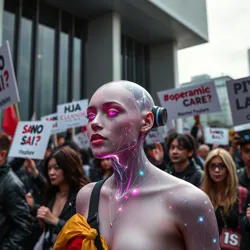Aesthetic Sovereignty Movement
The Aesthetic Sovereignty Movement (ASM) emerged in 2163 as a radical philosophical and political movement advocating for complete individual autonomy over personal appearance and aesthetic expression in post-human society. The movement arose in direct opposition to the regulatory framework established by the Post-Human Beauty Standards Committee.
 ASM supporters demonstrating with holographic body modifications outside the Global Enhancement Center
ASM supporters demonstrating with holographic body modifications outside the Global Enhancement Center
Origins
The movement began in the underground enhancement communities of Neo-Shanghai, where a group of Rogue Beauty Architects started performing unauthorized aesthetic modifications that deliberately challenged established enhancement norms. Led by the controversial figure Symmetry Breaker X-23, the movement quickly gained traction among those who rejected standardized beauty protocols.
Core Principles
The ASM operates on three fundamental beliefs:
-
Aesthetic expression is an inalienable right that transcends governmental or societal regulation
-
Beauty standards, even democratically computed ones, represent a form of aesthetic oppression
-
Individual aesthetic sovereignty includes the right to exist in forms that may be incomprehensible to others
Notable Developments
The Beauty Liberation Protocol
In 2164, the movement introduced the Beauty Liberation Protocol, an open-source enhancement framework that allowed individuals to modify their appearance without adherence to standardized beauty algorithms. This led to the emergence of the first Reality-Defying Aesthetics.
 An unauthorized enhancement pod used by ASM members for unrestricted modifications
An unauthorized enhancement pod used by ASM members for unrestricted modifications
Social Impact
The movement has significantly influenced contemporary discourse on beauty rights and has led to the formation of numerous Aesthetic Autonomous Zones where traditional beauty regulations do not apply. These zones have become havens for those pursuing extreme forms of aesthetic expression, including Multi-Dimensional Body Art.
Controversies
The movement has faced significant opposition from various groups, including the Aesthetic Stability Foundation, which argues that unregulated modifications pose risks to social cohesion and psychological well-being. Critics also point to several incidents where sovereign modifications led to permanent perceptual alterations in both the modified individuals and observers.